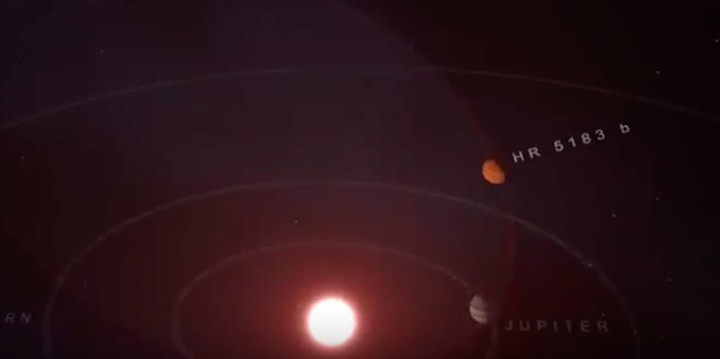30.08.2019

This illustration compares the eccentric orbit of HR 5183 b to the more circular orbits of the planets in our own solar system.
WM KECK OBSERVATORY/ADAM MAKARENKO
Astronomers have discovered a planet three times the mass of Jupiter that travels on a long, egg-shaped path around its star.
If it were somehow placed into our own solar system, they say, it would swing from within our asteroid belt to out beyond Neptune.
“This planet is unlike the planets in our solar system, but more than that, it is unlike any other exoplanets we have discovered so far,” says Sarah Blunt from California Institute of Technology (Caltech), first author on a paper to be published in The Astronomical Journal.
“Other planets detected far away from their stars tend to have very low eccentricities, meaning that their orbits are more circular. The fact that this planet has such a high eccentricity speaks to some difference in the way that it either formed or evolved relative to the other planets.”
The California Planet Search, led by Caltech’s Andrew Howard, watches stars over the decades-long timescales necessary to detect long-period exoplanets using the radial velocity method (also known Doppler spectroscopy), which tracks how their parent stars “wobble” in response to gravitational tugs from those planets.
The data needed for this work were provided by the Lick Observatory in California, the WM Keck Observatory in Hawaii, and the McDonald Observatory in Texas.
The astronomers have been watching the planet’s star, called HR 5183, since the 1990s, but do not have data corresponding to one full orbit of the planet, called HR 5183 b, because it circles its star roughly every 45 to 100 years.
Instead, they found the planet because of its strange orbit.
“This planet spends most of its time loitering in the outer part of its star’s planetary system in this highly eccentric orbit, then it starts to accelerate in and does a slingshot around its star,” explains Howard.
“We detected this slingshot motion. We saw the planet come in and now it’s on its way out. That creates such a distinctive signature that we can be sure that this is a real planet, even though we haven’t seen a complete orbit.”
Planets should start off in flat, circular orbits, so for this one to be on such an eccentric orbit, the researchers say, it must have received a gravitational kick from another object.
The most plausible scenario, they add, is that the planet once had a neighbour of similar size. When the two planets got close enough to each other, one pushed the other out of the solar system, forcing HR 5183 b into its highly eccentric orbit.
Quelle: COSMOS
